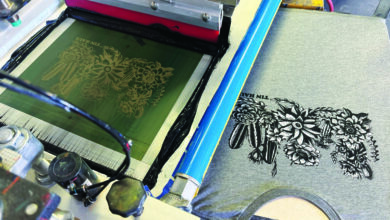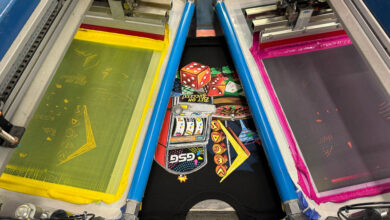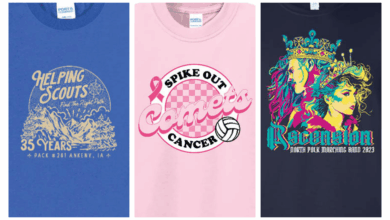
Different screen-printing inks come with different challenges. Whether you’re working with plastisol, discharge, water-based, or a special effect variety, there are some things to consider and take note of to ensure you’re next run is looking its best.
PLASTISOL
Dealing with the “bulletproof print” can be difficult, but it’s not impossible to resolve. Try focusing on these three components to avoid thick prints when working with plastisols.
Additives or bases: Use a plastisol softener from your ink vendor to be mixed in at a ratio specific to the manufacturer’s instructions or order pre-mixed soft-hand inks.
Mesh: The higher the mesh count, the less ink permeates through on each stroke. Also, the more detail it can hold.
Speed/pressure/angle: Think of your squeegee as a butter knife, the ink as the butter, and the shirt as the bread. If you want lots of butter, you won’t go straight up and down. That wouldn’t get any butter down on the bread, it would just sheer it off. Instead, kick it toward a 45-degree angle and spread slowly. If you go faster, you lay less down than when you go slower. If you have the squeegee straight up and down and press hard, you will sheer the ink and not put as much down as if you have it kicked back and pushed down a little light. So, start off around a 10 percent additional angle, as well as 40 psi of pressure (or medium pressure if printing manually) and play up or down from there to get the proper laydown for color matching and the hand desired.
Now, we can’t talk about plastisols without worrying about color shifts, AKA dye migration. To combat this issue, consider utilizing the tips below.
Dye-blocking underbase: Most plastisol manufacturers make a gray base that can help soak in the outgassed dye from the garment to avoid it seeping to the surface layers of ink printed over the underbase. You still need to use low cure and low bleed inks on top of this, including an additional white base on top of this base to assure your color matching. Make sure to use the tips in the bulletproof print point above to prevent this type of print from getting heavier than it needs.
DISCHARGE/WATER-BASED INK
Discharge and water-based inks can present various challenges, but the two most common include ink drying up in the screen and the screen breaking down during the run. Keep control of your process with these solutions.
Humidity: Ink drying up too quickly is almost always because the water in the ink is evaporating too fast, which will make it harder to flow. The best way to combat this is to try printing in a humid climate. If you’re in Florida, lucky you! The rest of us, however, will need to look at other ways of keeping the inks from drying out. The best way is to use the manufacturer’s additives that will include things to help keep “open time.” Another pro-tip would be to get a reptile fogger and mount it above your screen and position the cooling mist tube toward your ink. You can find foggers for around $30 at any pet store or online.
See this in action here: https://bit.ly/2MVyyE1
Emulsion: Water-based ink needs an emulsion that doesn’t break down with water, like standard photopolymers. Make sure you use something that stands up to water and friction continuously. Your local supplier can help point you in the right direction. If your emulsion is correct and this is still happening, chances are you are underexposed. If you don’t correctly crosslink the emulsion in the exposure, it has not completed its transformation into a solid and will break down easier. Invest in a good exposure calculator and test your times.
SFX PRINTING
One special effects ink that can give printers a hard time is puff ink. What if the puff isn’t puffing?
Temperature: Puff is picking up steam again, especially in streetwear and fashion brands. It’s an affordable and decently easy-to-use product. However, some printers have trouble using specific puff colors on different garment colors, and the “puff” aspect comes up missing. This is because the puff reacts to heat. If you overheat it, it can puff up and then deflate. Make sure you are hitting your 320 degrees F and not much over. Watch the dryer temp, and as long you lay down substantial coverage, puff should be a fun addition to your print repertoire.



